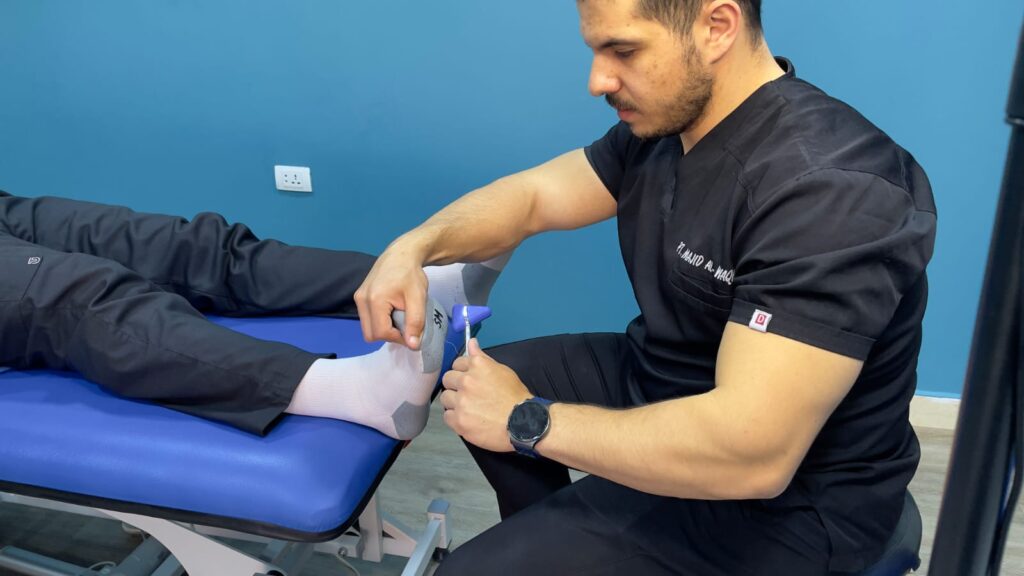Metatarsal Syndrome: Causes, Symptoms, Diagnosis, Prevention, and Treatment
Kilani
April 25, 2025

Metatarsal Syndrome Physiotherapy Introduction
Metatarsal Syndrome Physiotherapy is a condition that affects the metatarsal bones of the foot, leading to pain and discomfort in the forefoot region. It is commonly seen in athletes, individuals who spend prolonged periods standing, and those who wear inappropriate footwear. Understanding the causes, symptoms, and management of this condition is essential for effective treatment and prevention.
Causes of Metatarsal Syndrome Physiotherapy
Several factors contribute to the development of metatarsal syndrome, including:
Excessive Pressure: High-impact activities such as running, jumping, and dancing can put excessive stress on the metatarsal bones.
Improper Footwear: Wearing high heels, tight shoes, or shoes with inadequate support can alter foot mechanics, leading to excessive pressure on the forefoot.
This is the main cause that we see in kilani physiotherapy center in women that wear high heels due to work needs specially in UAE
Foot Deformities: Conditions like flat feet, high arches, bunions, and hammertoes can contribute to abnormal pressure distribution.
Aging and Osteoporosis: Bone density decreases with age, making the metatarsal bones more susceptible to stress fractures.
Obesity: Excess weight increases the load on the metatarsal bones, leading to strain and discomfort.
Nerve Disorders: Conditions such as Morton’s neuroma, where a nerve in the forefoot becomes compressed or irritated, can cause metatarsal pain.
Symptoms of Metatarsal Syndrome
The symptoms of metatarsal syndrome vary in severity but typically include:
Pain in the ball of the foot, especially when walking or standing for long periods
Swelling and inflammation around the affected area
Tingling or numbness in the toes
A sensation of walking on a pebble or having a lump under the foot
Difficulty wearing shoes due to tenderness in the forefoot
Diagnosis and Testing for Metatarsal Syndrome
A proper diagnosis of metatarsal syndrome requires a combination of clinical evaluation and imaging techniques:
Physical Examination: A doctor or physiotherapist will assess the affected foot for tenderness, swelling, and deformities.
Gait Analysis: Evaluating the way a person walks can help identify biomechanical abnormalities.
X-rays: These can reveal fractures, arthritis, or misalignment of the metatarsal bones.
MRI or CT Scan: Used in cases where soft tissue damage, nerve impingement, or stress fractures need further assessment.
Ultrasound: Helps detect soft tissue conditions such as neuromas or ligament injuries.
Prevention of Metatarsal Syndrome
Preventive measures can significantly reduce the risk of developing metatarsal syndrome:
Wearing Proper Footwear: Shoes with adequate cushioning, arch support, and a wide toe box can help distribute pressure evenly.
And in this point our physiotherapists in kilani physiotherapy center ask women who have a necessity of wearing high heels to change the shoes immediately after work and to do some massages and exercising their feet
Maintaining a Healthy Weight: Reducing excess body weight decreases the strain on the feet.
Gradual Increase in Activity: Avoid sudden increases in running or walking distance to prevent overuse injuries.
In kilani physiotherapy center we facing this with athletes clients mainly who have excessive training
Stretching and Strengthening Exercises: Strengthening foot muscles and improving flexibility can help support the metatarsal bones.
Using Orthotic Inserts: Custom or over-the-counter insoles can provide additional support and relieve pressure on the forefoot.
Treatment Options for Metatarsal Syndrome
Management of metatarsal syndrome includes conservative and medical interventions:
Rest and Activity Modification: Reducing high-impact activities to allow healing.
Ice Therapy: Applying ice packs to reduce inflammation and pain.
Pain Medications: Over-the-counter NSAIDs such as ibuprofen can help relieve discomfort.
Orthotics and Footwear Adjustments: Using metatarsal pads or orthotic inserts can alleviate pressure on the affected area.
Physical Therapy: A structured rehabilitation program can improve foot mechanics and prevent recurrence.
Surgical Intervention: In severe cases, surgery may be required to correct structural deformities or relieve nerve compression.
The Role of Physiotherapy in Treatment
Physiotherapy plays a crucial role in managing metatarsal syndrome by addressing biomechanical issues and improving foot function. Key physiotherapy interventions include:
Manual Therapy: Mobilization techniques to improve joint alignment and reduce stiffness.
In all our branches Dubai, Sharjah and Amman we focus on this type of therapy due to its effectiveness with healing the patients.
Stretching Exercises: Targeting the calf muscles, plantar fascia, and intrinsic foot muscles to enhance flexibility.
Strengthening Exercises: Focusing on the intrinsic foot muscles to improve arch support and distribute pressure evenly.
Gait Training: Correcting walking patterns to minimize excessive stress on the metatarsals.
Taping and Padding: Providing temporary relief by offloading pressure from the affected area.
Ultrasound or Laser Therapy: Using modalities to promote healing and reduce inflammation.
Patient Education: Advising on footwear selection, activity modifications, and home exercise programs.
Conclusion
Metatarsal syndrome is a common foot condition that can cause significant discomfort if left untreated. Understanding its causes, symptoms, and treatment options is essential for effective management. Physiotherapy plays a vital role in rehabilitation, helping individuals regain pain-free movement and prevent recurrence. By adopting preventive measures and seeking timely medical intervention, individuals can successfully manage and recover from metatarsal syndrome.
If you suffer from this condition, do not hesitate to contact us at our branches in Jordan,Dubai and Sharjah
